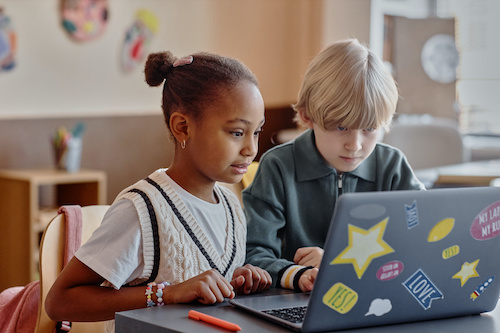
Key points:
- When students use robots, they unlock key SEL skills
- Robots play a key role for students in early STEM education
- 3 keys to success when introducing robotics to young learners
- For more on robots in education, visit eSN’s STEM & STEAM hub
Our students are growing into a world where they will find themselves sharing their space, work, and lives with more and more robots. More than a year ago I read an article about McDonald’s using robot arms to make french fries, so even a job as straightforward as fry cook will be performed by a human-robot team–even if the human’s part is only maintaining the robot. We need to prepare our students for a world in which they are routinely interacting with technology that needs to be programmed.
Even as they will be required to program machines, they will still have to collaborate, problem solve, and engage in all the very human soft skills. That’s why at Jacksonville Independent School District we like to combine social-emotional learning with coding education. Here’s how it has worked since we introduced virtual robotics at our middle school.
Existing STEM programs
A few years ago, we were looking for a robotics solution for our middle school students to use primarily to get them engaged with engineering before high school. At the time, we did not have a robotics course for middle grades at all, though we did have an after-school STEM club.
Because I had some experience with robotics at my previous school, our career and technical education (CTE) coordinator and principal asked me what I would need to support a robotics course. I landed on LEGO Education Spike kits and CoderZ because they met the Robotics I standards course, lined up well with my previous robotics education experience, and because there was a competitive aspect that would help to engage students. Because we already had a team competing in the University Interscholastic League robotics competition, I thought CoderZ’s League in a Box offering would be a good fit.
Virtual robotics and soft skills
We began using virtual robots for coding education in 2020, but really leaned into them as COVID emerged, because virtual robots were easier to work with given pandemic restrictions.
We found that in addition to reducing the potential of cross contamination, virtual robots were also great for trial-and-error problem solving. With robots in general, and especially with virtual robots, students are more likely to try stuff without fear of failure because it’s just a robot—or, in our case, it’s just a collection of click-and-drag images. They hit “play,” the robot does its thing, it either works or it doesn’t, and the students just naturally move on to building a bit more to try their next idea.
My suggestions don’t have to work, because now they are back on their robot, examining the code for other things to change up and test out. They don’t need a solution from me, and I don’t have to be a robotics or programming expert. I just have to be able to get them thinking about their challenge and talking out loud about how they might solve it.
In the past, in fact, many of the teachers or after-school educators I worked with on robotics were more like facilitators than traditional teachers, which can be pretty powerful. Students know they are figuring it out themselves when they see you learning alongside them. That’s both incredibly engaging and empowering for students, and sets a vivid example of lifelong learning. It helps students develop self-esteem and confidence that transfers not just to all their other subjects, but to every aspect of their lives.
Another way we like to boost the practice of these collaborative and communicative skills is to encourage students to help their classmates if they find success before their peers. They almost move into the teacher’s role as they start asking others, “Well, what have you tried?” or reassure them by reminding them, “This was the 100th thing I tried before it finally worked.”
Lessons learned
To be sure you are baking in those soft skills, look for tools and lessons that have guiding questions and reflection prompts. These don’t have to be groundbreaking or deeply insightful questions. You just want to get the conversation going and have tools to help connect the activity back to your curriculum. Having a few suggestions with each lesson to get you started can be incredibly helpful.
Don’t be afraid to start small and begin with what you can afford and what you know you will use. Even if it’s just a handful of kids in a single class, you can find out what they love and what they don’t care so much about–and build your program up bigger later.
Starting small extends to each lesson, as well. Our virtual robotics program eases students in with a quick tutorial that shows the specific coding blocks they will use, which eliminates some options to reduce overwhelm and allows students to focus on things like problem solving, coming up with creative solutions, and communicating and collaborating with peers. This is particularly helpful with younger students.
It’s also a great idea to choose self-paced activities. Our virtual robotics program allows us to choose between releasing a unit at a time to students, having them take on activities in chronological order, or allowing them to complete lessons at their own pace. We’ve found that the self-paced option works best to keep students engaged and to avoid overwhelming them by not giving them too much at one time.
It’s been amazingly gratifying to see students grow in problem solving, communication, and collaboration skills–and to watch them transfer all of that to other classes. Some people may say you can’t teach confidence, but they’ve never watched a kid from their robotics class go from struggling in math to realizing they can work through their challenge by trying something new, by chatting with someone going through the same thing, or by simply sticking with it until it’s done.
At Jacksonville Independent School District we like to combine social-emotional learning with coding education. Here’s how it has worked since we introduced virtual robotics at our middle school. Coding and Robotics, Featured on eSchool News, STEM & STEAM, collaboration, creativity, engineering, need, robot, robots, skills, soft skills, students, teach eSchool News



